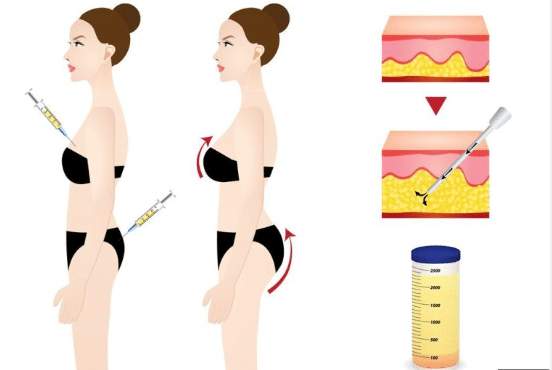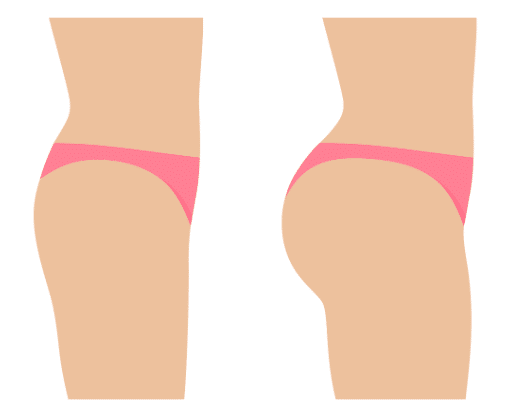When considering different types of fat transfer procedures, individuals delve into techniques such as fat grafting, autologous fat transfer, lipofilling, and adipose tissue transplantation. These methods involve harvesting fat from one area of the body and injecting it into another to enhance volume and contour, offering natural-looking results. Understanding the nuances and benefits of each approach is crucial for achieving desired aesthetic outcomes tailored to individual needs.
Why People Need Fat Transfers
Fat transfers offer a range of benefits and address various aesthetic concerns. Here are some reasons why individuals choose fat transfer procedures:
- Volume Restoration: Fat transfers can restore volume to areas that have lost their youthful fullness due to aging or weight loss, such as the face, breasts, and buttocks.
- Enhanced Breast Size and Shape: Fat transfer breast augmentation is an alternative to traditional implants, offering a more natural-looking and feeling result.
- Facial Rejuvenation: Facial fat transfer helps reduce wrinkles, plump up sunken areas, and enhance facial contours, leading to a more youthful appearance.
- Scar Revision: Fat transfers can be used to improve the appearance of scars, making them less noticeable.
- Buttock Augmentation: The Brazilian Butt Lift procedure utilizes fat transfer to sculpt and enhance the shape and size of the buttocks.
Clinic contact number: +989371200167
Different Types of Fat Transfer
Fat Transfer Breast Augmentation
Fat transfer breast augmentation involves removing fat from one area of the body, such as the abdomen or thighs, through liposuction. The extracted fat is then purified and injected into the breasts to increase their size and improve their shape. This procedure provides a more natural and subtle enhancement compared to traditional breast implants.

Facial Fat Transfer
Facial fat transfer is a popular technique used to restore volume and rejuvenate the face. Fat is harvested from donor sites, usually the abdomen or thighs, and is then injected into areas of the face that have lost volume, such as the cheeks, temples, or under-eye hollows. This procedure helps to smooth wrinkles, add youthful plumpness, and improve overall facial harmony.
Facial fat transfer surgery, also known as fat grafting or fat injection, is a cosmetic procedure that aims to restore volume, enhance facial contours, and rejuvenate the overall appearance of the face. This innovative technique involves transferring a patient’s own fat from one part of their body to another, typically from areas with excess fat, such as the abdomen, thighs, or buttocks, to areas that lack volume or have experienced age-related volume loss in the face.
Process
- Consultation: The process typically begins with a consultation with a plastic surgeon. During this consultation, the surgeon assesses the patient’s facial structure, discusses their goals, and determines if they are a suitable candidate for the procedure.
- Harvesting Fat: In the operating room, the surgeon performs liposuction to extract fat from the donor area. The fat is carefully removed to ensure viability for transfer.
- Purification: Once harvested, the fat is processed to remove excess fluids, blood, and impurities. This step is crucial for enhancing the survival rate of the transferred fat cells.
- Injection: The purified fat is then injected into targeted areas of the face using small cannulas. The surgeon strategically places the fat to achieve the desired volume and contour improvements. Multiple injections may be needed to achieve the desired result.
- Recovery: After the procedure, patients may experience swelling, bruising, and discomfort at both the donor and injection sites. Recovery time varies but usually takes a few days to a week.
- Results: Over the following weeks and months, the transferred fat cells establish a blood supply from the surrounding tissue and integrate into the recipient site. Some initial volume loss is expected, but the remaining fat cells should provide long-lasting results.
Facial fat transfer, also known as fat grafting or autologous fat transplantation, is a cosmetic procedure where fat is harvested from one part of the body (usually abdomen, thighs, or buttocks) through liposuction and then injected into the face to enhance volume, fill in wrinkles or folds, and improve overall facial contours. This procedure can be used to address areas such as sunken cheeks, hollow under eyes, thin lips, or other facial volume deficiencies.
Clinic contact number: +989371200167
Benefits
- Natural Results: Since the patient’s own fat is used, the results tend to look and feel natural.
- Dual Benefit: Patients benefit from both fat removal in the donor area and enhanced facial contours.
- Longevity: While not all transferred fat cells survive, the ones that do can provide long-lasting results.
- Minimal Risk of Allergic Reaction: Since the fat comes from the patient’s own body, there is a minimal risk of allergic reaction or rejection.
Brazilian Butt Lift
The Brazilian Butt Lift (BBL) is a specialized fat transfer procedure that focuses on enhancing the shape and size of the buttocks. It involves harvesting fat from areas with excess fat, such as the abdomen, hips, or thighs, purifying it, and injecting it into the buttocks. This technique provides a more shapely and lifted appearance, creating the coveted hourglass figure.
The Brazilian Butt Lift (BBL) is a cosmetic surgical procedure that has recently gained immense popularity. It enhances the buttocks’ shape, size, and contour, creating a youthful and voluptuous appearance.

The Rise of Fat Transfer Techniques
Different Types of Fat Transfer have become a focal point in both cosmetic and reconstructive surgery, offering innovative solutions for volume enhancement and contouring of various body parts. Institutions like Harvard Medical School and Johns Hopkins University have been at the forefront, pioneering research and clinical applications in this arena.
Esteemed professionals such as Dr. Sydney Coleman have made significant contributions to the field, particularly in refining techniques for autologous fat grafting. This process involves harvesting fat from one part of the body, purifying it, and then reinjecting it into another area, necessitating a high degree of precision and expertise. Advanced methodologies, including the use of stem cells within the transferred fat, have been a subject of study to improve graft survival and outcomes.
In recent years, the most active entities in the realm of Different Types of Fat Transfer have not only been academic institutions but also specialized clinics and hospitals. The Miami Fat Transfer Clinic stands out for its high volume of procedures and continuous innovation in fat grafting techniques.
Industry statistics reveal a significant uptick in the demand for fat transfer procedures, with over 250,000 interventions performed annually worldwide, demonstrating a year-on-year growth of approximately 17%. The popularity of this procedure is largely attributed to its dual benefit: reduction of unwanted fat in donor sites and enhancement of recipient sites, offering a natural alternative to synthetic fillers. The evolution of specialized equipment and refined techniques has further bolstered the success rates of these procedures, highlighting the dynamic and evolving nature of the field.
5 Tips About Fat Transfers
When considering a fat transfer procedure, it’s essential to keep the following tips in mind:
- Consultation: Schedule a consultation with a board-certified plastic surgeon to discuss your goals, expectations, and medical history.
- Donor Site Selection: Choose a donor site with sufficient fat for harvesting, and discuss with your surgeon which area would best suit your desired outcome.
- Expectations: Understand that fat transfer results may vary, and multiple sessions might be required to achieve the desired outcome.
- Recovery: Follow post-operative care instructions carefully, including rest, proper wound care, and avoiding strenuous activities.
- Long-Term Maintenance: Maintain a healthy lifestyle to optimize fat survival and ensure long-lasting results.
Adipose tissue is viewed as ideal filler because it is readily available, is host compatible, and can be harvested easily and repeatedly as needed without complications arising from allergic or foreign body reactions.Academic OUP
10 Risks of Fat Transfers
While fat transfers are generally safe, like any surgical procedure, they carry some risks. These potential risks include:
The cost of fat grafting is influenced by various factors, including the volume of fat transferred, which directly impacts the complexity and duration of the procedure. Surgeon’s expertise plays a critical role in determining the pricing, as experienced professionals often command higher fees for their advanced skills, particularly in facial rejuvenation and body contouring. Consequently, facial rejuvenation costs and body contouring pricing vary significantly, reflecting the tailored approach to each patient’s aesthetic goals and the technical demands of achieving natural-looking results.
- Infection: Infection can occur at the site of fat extraction or the injection site.
- Bleeding: Excessive bleeding can occur during or after the procedure.
- Asymmetry: There is a possibility of unevenness or asymmetry in the treated area.
- Fat Resorption: Some of the transferred fat may be reabsorbed by the body over time, potentially affecting the longevity of results.
- Contour Irregularities: The injected fat may result in lumps, bumps, or irregular contours.
- Scarring: Scarring may occur at the incision sites used for fat extraction and injection.
- Skin Discoloration: Temporary discoloration or pigmentation changes can occur at the treated areas.
- Necrosis: In rare cases, the transferred fat may not receive sufficient blood supply, leading to tissue death.
- Allergic Reactions: Although uncommon, some individuals may experience allergic reactions to the anesthesia or medications used during the procedure.
- Persistent Swelling: Swelling may persist for an extended period after the surgery, requiring time to fully subside.
Understanding the different types of fat transfer procedures and their benefits can help individuals make informed decisions
summary
In conclusion, the diverse range of fat transfer techniques, including structural fat grafting, the Coleman technique, liposculpture, autologous fat transfer, and lipofilling, presents patients with versatile options for achieving their aesthetic goals. Structural fat grafting, emphasizing the strategic placement of fat to create natural contours and rejuvenation, stands out for its ability to address volume loss and provide long-lasting results.
The Coleman technique, pioneered by Dr. Sydney R. Coleman, has revolutionized fat transfer by refining the process of harvesting, processing, and injecting fat to ensure optimal survival and integration. Meanwhile, liposculpture offers a sculpting approach, removing excess fat from one area and strategically transferring it to enhance volume and shape in another, catering to patients seeking both refinement and augmentation. Overall, by understanding the nuances and benefits of each technique, patients can make informed decisions to achieve personalized and satisfying outcomes in their fat transfer journeys.
Clinic contact number: +989371200167
FAQs
1. What is fat transfer?
Fat transfer, also known as fat grafting, is a cosmetic procedure that involves transferring fat from one area of the body to another to enhance volume and contour.
2. What areas of the body can be treated with fat transfer?
Fat transfer can be performed on various areas, including the face, breasts, buttocks, and hands, to restore volume and improve aesthetics.
3. How long do fat transfer results last?
Fat transfer results are long-lasting, but some of the transferred fat may be reabsorbed by the body over time. Maintaining a stable weight can help optimize and maintain the results.
4. What is the recovery process like after fat transfer?
Recovery from fat transfer varies depending on the extent of the procedure and the areas treated. Generally, patients can expect some swelling, bruising, and discomfort at both the donor and recipient sites, which typically subside within a few weeks. Patients are advised to avoid strenuous activities and follow post-operative care instructions provided by their surgeon.
5. Are the results of fat transfer permanent?
While some of the transferred fat may be reabsorbed by the body in the weeks following the procedure, the remaining fat typically establishes blood supply and becomes long-lasting. However, factors such as weight fluctuations and aging can affect the longevity of the results.
6. Can anyone undergo fat transfer?
Ideal candidates for fat transfer are generally in good overall health, have realistic expectations, and have sufficient donor fat for harvesting. However, individual suitability for the procedure is determined during a consultation with a qualified plastic surgeon.
https://academic.oup.com/asj/article/33/5/713/2801392?login=false




